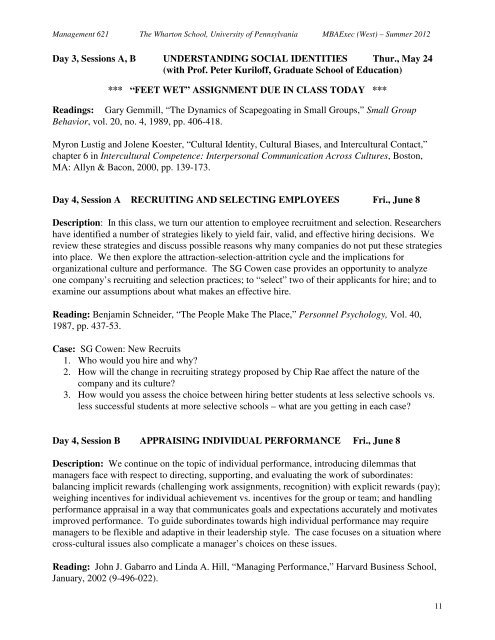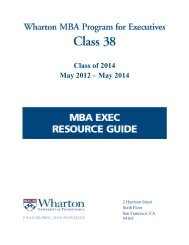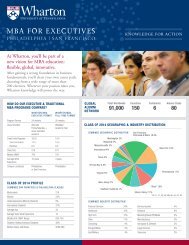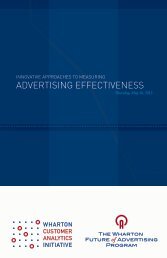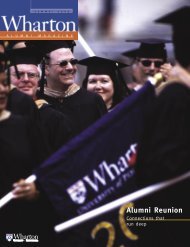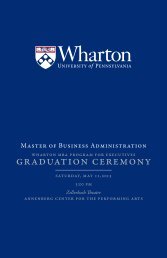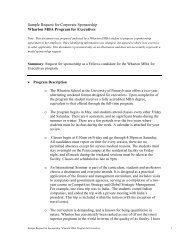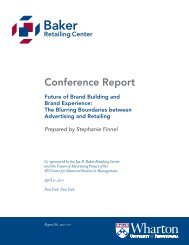version Date: April - The Wharton School of the University of ...
version Date: April - The Wharton School of the University of ...
version Date: April - The Wharton School of the University of ...
Create successful ePaper yourself
Turn your PDF publications into a flip-book with our unique Google optimized e-Paper software.
Management 621 <strong>The</strong> <strong>Wharton</strong> <strong>School</strong>, <strong>University</strong> <strong>of</strong> Pennsylvania MBAExec (West) – Summer 2012<br />
Day 3, Sessions A, B UNDERSTANDING SOCIAL IDENTITIES Thur., May 24<br />
(with Pr<strong>of</strong>. Peter Kuril<strong>of</strong>f, Graduate <strong>School</strong> <strong>of</strong> Education)<br />
*** “FEET WET” ASSIGNMENT DUE IN CLASS TODAY ***<br />
Readings: Gary Gemmill, “<strong>The</strong> Dynamics <strong>of</strong> Scapegoating in Small Groups,” Small Group<br />
Behavior, vol. 20, no. 4, 1989, pp. 406-418.<br />
Myron Lustig and Jolene Koester, “Cultural Identity, Cultural Biases, and Intercultural Contact,”<br />
chapter 6 in Intercultural Competence: Interpersonal Communication Across Cultures, Boston,<br />
MA: Allyn & Bacon, 2000, pp. 139-173.<br />
Day 4, Session A RECRUITING AND SELECTING EMPLOYEES Fri., June 8<br />
Description: In this class, we turn our attention to employee recruitment and selection. Researchers<br />
have identified a number <strong>of</strong> strategies likely to yield fair, valid, and effective hiring decisions. We<br />
review <strong>the</strong>se strategies and discuss possible reasons why many companies do not put <strong>the</strong>se strategies<br />
into place. We <strong>the</strong>n explore <strong>the</strong> attraction-selection-attrition cycle and <strong>the</strong> implications for<br />
organizational culture and performance. <strong>The</strong> SG Cowen case provides an opportunity to analyze<br />
one company’s recruiting and selection practices; to “select” two <strong>of</strong> <strong>the</strong>ir applicants for hire; and to<br />
examine our assumptions about what makes an effective hire.<br />
Reading: Benjamin Schneider, “<strong>The</strong> People Make <strong>The</strong> Place,” Personnel Psychology, Vol. 40,<br />
1987, pp. 437-53.<br />
Case: SG Cowen: New Recruits<br />
1. Who would you hire and why<br />
2. How will <strong>the</strong> change in recruiting strategy proposed by Chip Rae affect <strong>the</strong> nature <strong>of</strong> <strong>the</strong><br />
company and its culture<br />
3. How would you assess <strong>the</strong> choice between hiring better students at less selective schools vs.<br />
less successful students at more selective schools – what are you getting in each case<br />
Day 4, Session B APPRAISING INDIVIDUAL PERFORMANCE Fri., June 8<br />
Description: We continue on <strong>the</strong> topic <strong>of</strong> individual performance, introducing dilemmas that<br />
managers face with respect to directing, supporting, and evaluating <strong>the</strong> work <strong>of</strong> subordinates:<br />
balancing implicit rewards (challenging work assignments, recognition) with explicit rewards (pay);<br />
weighing incentives for individual achievement vs. incentives for <strong>the</strong> group or team; and handling<br />
performance appraisal in a way that communicates goals and expectations accurately and motivates<br />
improved performance. To guide subordinates towards high individual performance may require<br />
managers to be flexible and adaptive in <strong>the</strong>ir leadership style. <strong>The</strong> case focuses on a situation where<br />
cross-cultural issues also complicate a manager’s choices on <strong>the</strong>se issues.<br />
Reading: John J. Gabarro and Linda A. Hill, “Managing Performance,” Harvard Business <strong>School</strong>,<br />
January, 2002 (9-496-022).<br />
11


